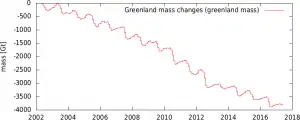
A now internationally known (or infamous?) Swedish teenager has urged us all, and especially the politicians, to listen to (climate) researchers. A call that other climate-threatening activists also support. Then, surely, with the ability to think critically, why no climate scientist was allowed to speak at the UN Climate Summit in New York recently?
Let’s see what the climate scientists, and climate research, have to say then. This research is compiled at fairly regular intervals by the IPCC. A compilation made by the IPCC Working Group 1 (WGI). There are two more working groups, which write reports on the consequences of climate change, and what can be done about it. I don’t call that climate research. Possibly it can be called climate change research, ie research on the possible consequences of climate change.
IPCC’s latest summary of climate research, The Physical Science Basis, came in 2013. It is possible to see what the researchers thought then, at least according to the selection made by those responsible for the report. That message, as I can see, does not provide much support for notions of an ongoing climate crisis or an impending climate disaster.
Since then, new research results have emerged. So what do we know if we listen to what scientists and research have come up with since then?
For example, we have François Gervais, who believes that the climate has a 60-year cycle that is more important for explaining climate change than what the carbon dioxide content is. Anyone looking at a long-range temperature range for the Earth’s surface, like HadCRUT4, doesn’t need much imagination to think of seeing a 60-year cycle superimposed on a linear trend. Still, I’m a little doubtful that this bike is real. If it is real, after all, the measurements have only covered two of the cycles. It would need at least three to be reasonably certain that the bike is real and not the result of a coincidence.
A common argument that it must be greenhouse gas emissions behind the latest global warming, there is no other explanation. Which reminds me of the filth’s reasoning in the joke with the point that he was looking for the lost key bundle in the light from the street lamp, because it was too dark to look elsewhere. Or then translated to this case that one has not really looked for any causes other than greenhouse gas emissions.
In itself, the researchers agree that there is another possible explanation. Which is one of the few things the scientists really agree on. The sun is then this second possibility. Whether it is solar radiation, solar activity or the latter’s influence on cosmic radiation. Or why not a combination of them?
However, the sun as explanation is usually dismissed because the variations in solar radiation at the top of the atmosphere are only a few tenths of a percent. It is not enough to explain the climate change at the soil surface.
The peak of the atmosphere, it is above clouds, dust particles and air pollution there. Which means that variations in solar radiation up there may not have much to do with climate change. What is interesting, however, is how much solar radiation, solar activity and cosmic radiation affect what happens further down in the atmosphere. What matters is the amount of solar radiation reaching the earth’s surface, not the amount reaching the top of the atmosphere.
The sun does affect the climate, according to many researchers and much research. Just last year, 2018, 92 scientific articles were published with that message, according to NoTricksZone. If we listen to the researchers, there is no reason to worry about global warming, or to take any drastic climate measures. Rather, maybe we should worry about it getting colder over the next few years?
It is not even certain that the variations in solar radiation at the top of the atmosphere are as small as it is often claimed. These variations have only been measured by satellite since the 1970s. There have been different satellites, with different instruments and sometimes lack of overlap in time between them. It has been difficult to get the measurements from different satellites together.
Before the satellites, there are some measurements from the Earth’s surface, about 100 years back in time. Before that, it is only possible to obtain variations in solar radiation through various indicators, since the solar radiation itself does not leave any permanent traces. Cosmic radiation, on the other hand, leaves traces as it creates the two radioactive isotopes beryllium-10 and carbon-14 when it collides with molecules in the atmosphere. The cosmic radiation is affected by the solar wind, which in turn varies with the solar activity. There also seems to be a correlation between variations in solar radiation and solar activity.
Different research groups have done analyzes with different results. Results showing that variations in solar radiation (to the top of the atmosphere) may have been from negligible to greater than the effect of more greenhouse gases in the atmosphere. The climate-threatening activists certainly want us to listen to the former scientists, but it may well be the latter who are right.
Although climate change is now mainly caused by variations in the levels of carbon dioxide and other greenhouse gases, there is no danger on the roof if the impact is small. Which is determined by climate sensitivity. This parameter was previously expressed as the change in global mean temperature that is the result of a certain change in energy supply to the earth’s surface. Nowadays it is usually expressed as the global warming that results from a doubling of (equivalent) carbon dioxide content.
There is research showing that the climate sensitivity is low. Which in practice means that the climate disaster is set, the climate crisis will never come to fruition and that there is no reason for drastic climate action. Although the researchers themselves do not usually express it exactly so.
One of these research studies was done by Craig Loehle in 2014. He concluded that climate sensitivity is low. He is not alone in that. Nic Lewis has made several determinations and come to the same conclusion. Among other things, together with Judith Curry 2018.
There are different climate sensitivities, depending on the time period you are interested in. The most important is the one abbreviated TCR, for Transient Climate Response in English. It indicates how much global warming it will be in a period of decades up to a century, if the carbon dioxide content is doubled. The researchers reasonably agree that more than two degrees of global warming entails serious climate change. If the climate sensitivity is then below 1.5 ° C, or maybe even below 1 ° C, the climate disaster is actually set and the climate crisis never occurs.
If we listen to researchers like Loehle, Lewis and Curry, then there is no need to worry about a climate threat, but instead focus on real problems that do not have to do with climate change.
In Swedish media, we are often fed with allegations of acceleration of various climate trends. One example is that the melting of Greenland’s ice cover is said to be progressing faster. If we listen to the researchers, does it seem right? For example, an article by Ruan et al. published this year. They claim that the trend has recently decelerated.
A study by Danish researchers shows that the rate of decline has also slowed down for 47 Greenlandic glaciers that reach the sea and can then calve icebergs.
Greenland’s ice cover has in some ways been measured by the Grace satellites. These actually measured variations in gravitational fields. Since then, researchers have used models to recalculate variations in ice cover changes in, for example, Greenland. These calculations are available, among other things, on Climate Explorer. The chart with this data looks like this:

These data also indicate that the melting rate has slowed rather than accelerated recently. Although we may not be listening to the scientists behind the Grace satellites, which, incidentally, have stopped working now?
There are more researchers that the climate-threatening activists probably think we should not listen to. Just last year, 2018, for example, over 500 scientific articles were published that in various ways question carbon dioxide as the dominant, or perhaps the only, cause of climate change. There are many scientists we can listen to, but if we listen to them we do not go out on Fridays and demonstrate for draconian climate measures.
The climate-threatening activist, who we think should listen to the researchers in order to become convinced supporters of the climate threat church, apparently has very poor knowledge of what the researchers have come up with. Or the activists mean that we should only listen to a small group of researchers. A crowd that is probably chosen by the activists themselves.

Leave a Reply